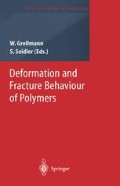Abstract
It is well known that toughness, defined in the engineering sense as the material resistance against stable and unstable crack propagation or fracture, is a highly important material property. Since excessively small values of toughness often restrict the application fields of polymeric materials, various ways derived from materials science of toughening brittle polymers (for instance SAN) have been developed (such as blending with or without compatibilizer, and copolymerization). This toughening is achieved by heterogenization of the material, i.e. incorporation of fmely dispersed rubber particles into the matrix material [1]. Morphological parameters such as particle size and distance, matrix—particle adhesion, and the internal structure of particles, which vary with production conditions (i.e. synthesis and processing), strongly affect the morphology—toughness correlations since the processes of stable and unstable crack initiation and propagation and of energy dissipation are influenced in different ways.
Access this chapter
Tax calculation will be finalised at checkout
Purchases are for personal use only
Preview
Unable to display preview. Download preview PDF.
References
Bucknall C. B. (1977): Toughened Plastics. Applied Science, London
Merkle J. G., Corten H. T. (1974): ASME Paper 74. J. Pressure Vessel Technol. 96, 4: 286ff.
Grellmann W., Sommer J.-P. (1986): Toughness properties description of polymers using the J-integral concept. In: Fracture Mechanics, Micromechanics and Coupled Fields (FMC) Series, No. 17, Institut für Mechanik, Berlin, Chemnitz: 48–72
Grellmann W., Jungbluth M. (1987): Application of the crack-opening displacement concept for determining geometry-independent fracture mechanical parameters in the instrumented Charpy impact test. In: Fracture Mechanics, Micromechanics and Coupled Fields (FMC) Series, No. 37, Institut für Mechanik, Berlin, Chemnitz: 186–192
Leevers P. S. (1999): Fracture mechanics. In: Swallowe G. M. (Ed.) Mechanical Properties and Testing of Polymers–An A-Z Reference. Kluwer Academic, Dordrecht: 96–101
Grellmann W., Seidler S. (1999): Possibilities and limits of standards and drafts for JR-curve determination on polymers. In: Winkler T., Schubert A. (Eds.) Material Mechanics–Fracture Mechanics–Micromechanics. DDP Goldenbogen, Dresden, Germany: 336–341
Nielsen I. E. (1967): Mechanical properties of particle-filled systems. J. Compos. Mater. 1: 100–119
Michler G. H. (1992): Kunststoff-Mikromechanik. Morphologie, Deformations-und Bruchmechanismen. Carl Hanser, Munich, Vienna
Grellmann W., Lach R. (1997): Toughness and relaxation behaviour of poly(methyl methacrylate), polystyrene and polycarbonate. Appl. Macromol. Chem. Phys. 253: 27–49
Lach R., Grellmann W. (2000): Estimation of the resistance against stable crack initiation and unstable crack propagation, R-curves and stability assessment diagrams in ductile polymeric ABS materials. In: Proceedings of the 13th European Conference on Fracture (ECF 13), San Sebastian, Spain, September 6–9, CD-ROM Polymer und Composites No. 20: 1–8
Gaymans R. J., Borggreve R. J. M., Oostenbring A. J. (1990): Toughening behavior of polyamide-rubber blends. Macromol. Chem. Macromol. Symp. 38: 125–136
Borggreve R. J. M., Gaymans R. J., Schuijer J. (1989): Impact behaviour of nylon-rubber blends: 5. Influence of the mechanical properties of the elastomer. Polymer 30: 71–77
Seidler S., Grellmann W. (1993): Fracture behaviour and morphology of PC/ABS blends. J. Mat. Sci. 28: 4078–4084
Author information
Authors and Affiliations
Editor information
Editors and Affiliations
Rights and permissions
Copyright information
© 2001 Springer-Verlag Berlin Heidelberg
About this chapter
Cite this chapter
Lach, R., Grellmann, W., Krüger, P. (2001). Crack Toughness Behaviour of ABS Materials. In: Grellmann, W., Seidler, S. (eds) Deformation and Fracture Behaviour of Polymers. Engineering Materials. Springer, Berlin, Heidelberg. https://doi.org/10.1007/978-3-662-04556-5_21
Download citation
DOI: https://doi.org/10.1007/978-3-662-04556-5_21
Publisher Name: Springer, Berlin, Heidelberg
Print ISBN: 978-3-642-07453-0
Online ISBN: 978-3-662-04556-5
eBook Packages: Springer Book Archive

